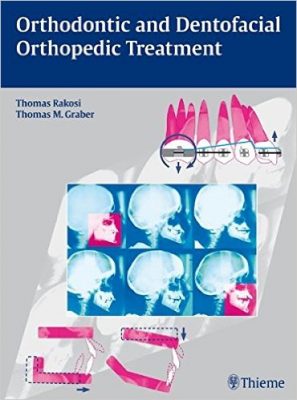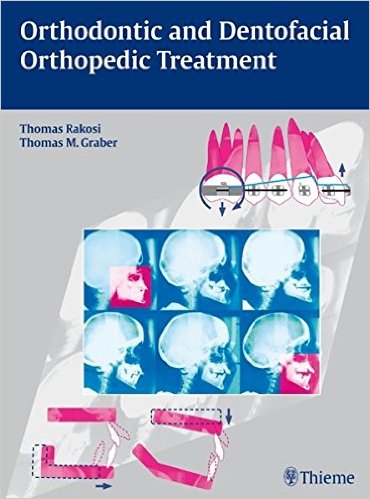 Editors: Thomas Rakosi, DDS; and Thomas N. Graber, DMD
Editors: Thomas Rakosi, DDS; and Thomas N. Graber, DMD
Publisher: Thieme – 364 pages, with 1,260 illustrations
Book Review by: Nano Khilnani
The profession of orthodontics has experienced steady progress based on extensive research around the world, write the editors of this large book. Here below, based on their introductory article, A Clinical Roadmap for the New Orthodontics, are some positive developments over the last few years that the two editors point out from their perspective:
- Bright individuals have come into orthodontics, due to increased demand for services
- Good financial returns have attracted companies to supply the equipment and tools
- Technical developments have kept pace with scientific advances
- More patients are being treated and ‘service’ is better than ever before
- Long-term evidence-based assessment of treatment results is now available
- Orthodontists and dentofacial orthopedists now know quite well what they can and cannot do
On the other hand, ‘legal vultures’ are trying frequently to win lawsuits against orthodontists, with large monetary rewards in contingency-fee-based cases, Drs. Rakosi and Graber point out. They also discuss in this article the coverage of each of the 16 chapters of this book.
Fourteen orthodontists including the two editors named above authored the chapters of this book. They are from eight countries: Australia, Canada, Czech Republic, Germany, Israel, Norway, Scotland, and the United States. Below we list the chapter titles of this book, to give you an overview:
- Therapeutic Diagnosis
- Preventive Orthodontics
- Early Treatment: Interceptive Guidance of Occlusion Including Serial Extraction followed by Mechanotherapy
- Functional Orthodontic and Functional Orthopedic Treatment
- The Twin Block Technique
- The Functional Magnetic System
- Early Maxillary Expansion
- The Interarch Compression Spring in Orthodontics
- Anchorage Control in Orthodontic Extraction Therapy
- Segmented Arch Mechanics
- The Alexander Discipline
- Implants and Orthdontics
- Treatment with the Invisalign System
- Stripping
- Active Retention Procedures
- Treatment Planning for Mandibular Distraction Osteogenesis
This is a large-size (about 9” x 12”) book with more than 1200 images. A large number and variety of full-color and black-and-white visual material – boxes, charts, diagrams, photos, and radiographs – are used to illustrate procedures and show the before-and-after views.
Organization of materials in the form of text and graphics used in each chapter follows, for the most part, a set system and order of presentation, with some variations.
A two-column block of text relating to the subject of the chapter title is at the beginning of each chapter. The discussion of the subject sometimes continues in the body of the chapter, or a new topic of discussion with a heading is introduced.
Other topics with headings follow. Because the size of the page is large, there is ample space to present visual material which certainly aids in the ease of learning and retention of facts (“a picture is worth a thousand words,” as has been said so many times).
Case studies are also presented in the book, making the book true to life (imagine not seeing any faces of people smiling, with their well-aligned, teeth! The book may be boring).
Among the benefits of using this book are:
- Clinical information on interceptive orthodontics, including discussion of guided extraction and functional orthopedics
- The biomechanics of orthodontic therapy for fixed and removable appliances
- Discussion of anchorage control and septal arch mechanics
- The latest methods for solving tooth-size discrepancies, morphologic variations, and recrowding in the lower anterior segment
- 1260 drawings, photos, and radiographs – most in full-color
Editors:
Thomas Rakosi, DDS, MD, MSD, PhD is Professor Emeritus and Former Chairman of the Department of Orthodontics in the School of Dental Medicine at Albert Ludwigs University in Freiburg, Germany.
Thomas N. Graber, DMD, MSD, PhD, Odont Dr hc, DSc, ScD, deceased, is former Clinical Professor of Orthodontics in the Department of Orthodontics at the College of Dentistry at the University of Illinois in Chicago, Illinois.
Contributors:
R.G. “Wick” Alexander, DDS, MSD; William Clark, BDS, DDO; Jason B. Cope, DDS, PhD; Jack G. Dale, DDS; M. Ali Darendeliler, DDS; John DeVincenzo, DDS, MS; Magdalena Kotova, DDS, PhD; Andrew Kuhlberg, DMD, MSD; Michael R. Marcotte, DDS, MSD; Reoner-Reginald Miethke, Dr. med.dent., PhD; C. Brian Preston, BDS, PhD. MS and Certificate in Orthodontics; John J. Sheridan, DDS, ABO; Alexander Vardimon, DDS; and Bjorn Zachrisson, DDS, MSD, PhD.







